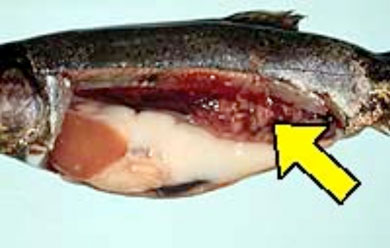Infections or infestations of animals that can be transmitted to humans are called zoonoses. Although cases of human disease arising from fish and shellfish are rare in Australia, there are a few ‘fish diseases’ that workers in the aquaculture and fishing industries need to be conscious of when handling or processing fish.
Mycobacteriosis and nocardiosis
Mycobacteriosis and nocardiosis are bacterial diseases that affect a wide range of freshwater and marine fish, but particularly aquarium fish. The bacteria cause chronic systemic infections that form lesions internally and externally.

Rainbow trout with mycobacteria lesions.
Affected aquarium fish show several symptoms such as anorexia, ‘popeye’, skin discolouration and external lesions such as ulcers, nodules and ‘fin rot’. Cold water salmonids may show no external signs of disease other than mortality, but post-mortem examination may reveal greyish-white lesions in the kidney, liver and spleen.
There is some debate as to whether infected fish can be successfully treated for these bacterial diseases. The destruction of infected stock and comprehensive disinfection of premises is usually recommended.
Symptoms in humans and treatment
Several species of these bacteria are capable of infecting humans. The bacteria enters through abrasions which can happen in swimming pools, working with tropical fish aquaria or from handling the guts of infected fish. Skin granulomas of the elbow, knees, fingers and feet may result.
A doctor should be consulted as soon as possible. The condition may persist for some time and must be treated with antibiotics for an extended period.
Three to four weeks after the bacteria enters the skin, a swelling develops over a bony lump or the site of an abrasion. A cyst, or abscess, develops that may be filled with pus and may ulcerate and scar. Lymph nodes may also swell.
Preventing infection
Wear protective gloves when cleaning fish aquaria or diving. If you suspect fish may be infected make sure you wear protective gloves when cleaning and filleting fish and disinfect the equipment you use afterwards.
Anisakis worms in the viscera of a blue mackerel
Anisakis nematodes
Anisakis and anisakis-like parasites are common nematode worms, the larvae of which infect many species of locally-caught fish. The parasite is transmitted by a fish eating crustacean zooplankton that is the intermediate host of the parasite, or by preying on a fish that are already infected.

Anisakis worms in the viscera of a blue mackerel.
These parasites have a complicated lifecycle with many intermediate hosts and may be transmitted several times from fish to fish before the final host is reached. The final hosts are marine mammals such as dolphins, whales and seals, where the adult worms cause serious inflammation of the stomach wall.
Anisakis larvae are 10 - 50 mm in length, white and normally tightly-curled in a cyst in the guts and muscle of the fish. Anisakiasis in humans can be acquired by eating raw or partially-cooked marine fish. The Anisakis larvae cause inflammation to the stomach wall. Some people can also develop an allergy to Anisakis larvae in seafood, even when properly cooked.

A simple life cycle of the Anasakis nematode – the adult worm is shown at the centre of the picture.
Symptoms in humans and treatment
Anisakis can cause severe gastric and intestinal pain, vomiting, and diarrhoea. In some severe cases there may be fever and blood in the stools. Anisakiasis is often misdiagnosed as stomach ulcers or appendicitis. Acute allergic reactions may occur with or without the gastric symptoms. Consult a doctor as soon as possible.
Preventing infection in humans
Avoid eating raw fish dishes. When cooking fish, cook for a minimum of five minutes at 60 degrees Celsius or a shorter time at higher temperatures.
If fish is to be eaten raw, it should preferably be frozen at -30 degrees Celsius. If storage is at -20 degrees Celsius, the fish should be frozen for at least five days. It is preferable to use farmed fish for raw dishes as these fish appear to be virtually free of infection. Marinating or smoking the fish will not necessarily kill Anisakis.
Crayfish handler’s disease (‘seal finger’)
The condition known as ‘crayfish handler’s disease’ is well known in the fishing industry. It can be caused by various bacteria, but particularly Erysipelothrix rhusiopathiae and various species of the Vibrio genus.
The bacteria enter the skin through abrasions, lacerations or fissures and cause a painful itching or burning sensation.
Symptoms in humans and treatment
There is an itching, burning sensation at the site of the injury, followed by swelling and the adjacent joints become stiff and painful. If left untreated the injury will heal in three weeks, although a relapse at a later date is possible.
There may be lymph node enlargement and inflammation but this is rare. Consult a doctor as soon as possible.
Preventing infection in humans
Thoroughly clean all marine cuts and injuries with antiseptic and keep them dry and clean. If handling marine animals, wear thick protective gloves. Wear thick boots when wading or fishing.